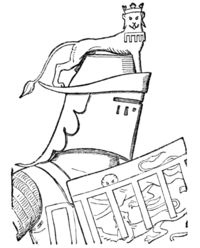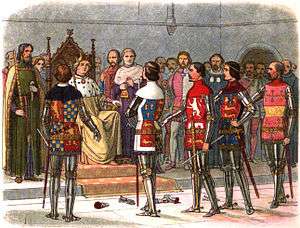Thomas de Mowbray, 1st Duke of Norfolk
Thomas de Mowbray, 1st Duke of Norfolk, 1st Earl of Nottingham, 3rd Earl of Norfolk, 6th Baron Mowbray, 7th Baron Segrave, KG, Earl Marshal (22 March 1366 – 22 September 1399) was an English peer. As a result of his involvement in the power struggles which led up to the fall of Richard II, he was banished and died in exile in Venice.
Thomas de Mowbray, 1st Duke of Norfolk | |
|---|---|
 Thomas de Mowbray, 1st Earl of Nottingham, from a drawing of his seal, 1389 | |
| Born | 22 March 1366 Epworth, Lincolnshire, England. |
| Died | 22 September 1399 (aged 33) Venice, Republic of Venice, Italy. |
| Buried | Venice, Italy. |
| Spouse(s) | Elizabeth le Strange Lady Elizabeth FitzAlan |
| Issue
Thomas de Mowbray, 4th Earl of Norfolk John de Mowbray, 2nd Duke of Norfolk Elizabeth de Mowbray, Countess of Suffolk Isabel de Mowbray, Baroness Berkeley Margaret de Mowbray, Lady Howard | |
| Father | John de Mowbray, 4th Baron Mowbray |
| Mother | Elizabeth de Segrave |

Origins
Mowbray was the second son of John de Mowbray, 4th Baron Mowbray, and Elizabeth de Segrave, suo jure Lady Segrave, daughter and heiress of John de Segrave, 4th Baron Segrave, by Margaret, daughter and heiress of Thomas of Brotherton, son of Edward I.[1] He had an elder brother, John de Mowbray, 1st Earl of Nottingham, and three sisters, Eleanor, Margaret and Joan (for details concerning his siblings see the article on his father, John de Mowbray, 4th Baron Mowbray).
Career

.jpg)
In April 1372, custody of both Thomas and his elder brother, John, was granted to Blanche Wake, a sister of their grandmother, Joan of Lancaster.[2]
On 10 February 1383, he succeeded his elder brother, John Mowbray, 1st Earl of Nottingham, as Baron Mowbray and Baron Segrave, and was created Earl of Nottingham on 12 February 1383.[3] On 30 June 1385 he was created Earl Marshal for life, and on 12 January 1386 he was granted the office in tail male.[4][lower-alpha 1] He fought against the Scots and then against the French. He was appointed Warden of the East March towards Scotland in 1389, a position he held until his death.
He was one of the Lords Appellant to King Richard II who deposed some of the King's court favourites in 1387. His party routed the royal favourite Robert de Vere, at the Battle of Radcot Bridge, and Richard was at their mercy. Owing partly to Mowbray's moderate counsels the suggestion to depose him was not carried out, but in the Merciless Parliament of 1388 the king's favourites were tried for treason and were sentenced to death.[6]
The king regained his power in 1389 and Mowbray worked his way back into his good graces. Richard detached Mowbray from his colleagues and made him warden of the Eastern March; later he became captain of Calais and the royal lieutenant in the north-east of France. The king took him to Ireland in 1394 and soon afterwards sent him to arrange a peace with France and his marriage with Isabella, daughter of Charles VI.[6] Mowbray was likely instrumental in the murder, in 1397, of the king's uncle (and senior Lord Appellant), Thomas of Woodstock, 1st Duke of Gloucester, who was imprisoned at Calais, where Nottingham was Captain. In gratitude, on 29 September 1397, the king created him Duke of Norfolk,[4][3] granting him Arundel's lands in Surrey and Sussex.[7]
In 1398, Norfolk quarrelled with Henry of Bolingbroke, 1st Duke of Hereford (later King Henry IV), apparently due to mutual suspicions stemming from their roles in the conspiracy against the Duke of Gloucester. Before a duel between them could take place, Richard II banished them both. Mowbray left England on 19 October 1398,[8] and was deprived of his offices, but not of his titles.[7] While in exile, he succeeded as Earl of Norfolk when his maternal grandmother, Margaret of Brotherton, Duchess of Norfolk, died on 24 March 1399.[8]
He died of the plague at Venice on 22 September 1399.[3] Bolingbroke returned to England in 1399 and usurped the crown on 30 September 1399; shortly afterward, on 6 October 1399, the creation of Mowbray as Duke of Norfolk was annulled by Parliament, although Mowbray's heir retained his other titles.[8][3]
Arms of Mowbray

The traditional, and historic arms for the Mowbray family are "Gules, a lion rampant argent". Although it is certain that these arms are differenced by various devices, this primary blazon applies to all the family arms, including their peerages at Norfolk. They are never indicated to bear the arms of Thomas Brotherton, nor any other English Royal Arms.
Sir Bernard Burkes, C.B., LL.D., Ulster King of Arms, in his book 'A General Armory of England, Scotland, Wales, and Ireland', 1884, page 713, provides the following detailed listing of the Mowbray/Norfolk arms:
"Mowbray (Duke of Norfolk, Earl of Nottingham, Earl of Warren and Surrey, Earl Marshal of England, and Baron Mowbray: dukedom and earldoms extinct 1475, when the barony fell into abeyance. The Mowbrays descended from Roger de Mowbray, son of Nigel d'Albini, who, possessing the lands of Mowbray [Montbray], assumed that surname by command of Henry I., his descendant, Roger de Mowbray, was summoned to Parliament 1295, the fifth baron was created Earl of Nottingham, 1377, d.s.p., his brother, the sixth Baron, was re-created Earl of Nottingham, 1383, constituted Earl Marshal, and created Duke of Norfolk, 139G, the fourth duke was created Earl of Warren and Surrey, vita patris, and d. without surviving issue, when all his honours became extinct except the barony, which fell into abeyance among the descendants of the daus. of the first Duke, of whom Lady Isabel is represented by the Earl of Berkeley, and Lady Margaret by the Lords Stourton and Pttre, as heirs general, and by the Duke of Norfolk, as heir male).
Gu. a lion ramp. ar.
Crest—A leopard or, ducally gorged ar.; granted by patent to the first duke, 17 Richard II. [1377–1399], which acknowledges his right to bear for his crest "a golden leopard with a white label," the crest of his maternal ancestor, Thomas Plantagenet, of Brotherton, Earl of Norfolk, and grants the coronet instead of the label, which would of right belong to the King's son.
Marriages and issue
He married firstly, after 20 February 1383, Elizabeth le Strange (c. 6 December 1373 – 23 August 1383), suo jure Lady Strange of Blackmere, daughter and heiress of John le Strange, 5th Baron Strange of Blackmere and Lady Isabel de Beauchamp, daughter of Thomas de Beauchamp, 11th Earl of Warwick, by whom he had no issue.[3]
He married secondly, Lady Elizabeth FitzAlan (c. 1372 – 8 July 1425), widow of Sir William Montagu, and daughter of Richard FitzAlan, 11th Earl of Arundel and Lady Elizabeth de Bohun, daughter of William de Bohun, 1st Earl of Northampton, by whom he had two sons and three daughters:[3]
- Thomas de Mowbray, 4th Earl of Norfolk.[9]
- John de Mowbray, 2nd Duke of Norfolk.[9]
- Lady Elizabeth de Mowbray, who married Michael de la Pole, 3rd Earl of Suffolk.[9]
- Lady Margaret de Mowbray, who married firstly Sir Robert Howard, by whom she was the mother of John Howard, 1st Duke of Norfolk, and secondly Sir John Grey of Ruthin, Derbyshire.[9]
- Lady Isabel de Mowbray; married firstly Sir Henry Ferrers, son of 5th Baron Ferrers of Groby, and secondly James Berkeley, 1st Baron Berkeley.[9]
Shakespeare
Mowbray's quarrel with Bolingbroke and subsequent banishment are depicted in the opening scene of Shakespeare's Richard II.[10] Thomas Mowbray (as he is called in the play) prophetically replies to King Richard's "Lions make leopards tame" with the retort, "Yea, but not change his spots." Mowbray's death in exile is announced later in the play by the Bishop of Carlisle.
Ancestry
| Ancestors of Thomas de Mowbray, 1st Duke of Norfolk | ||||||||||||||||||||||||||||||||||||||||||||||||||||||||||||||||||||||||||||||||||||||||||||||||||||||||||||||||||||||||||||||||||||||||||||||||||||||||||||||||||||||||||||||||||||||||||||||||||||||||||||||||||||||||||||||||||||||||||||||||||||||||||||||||||||||||||||||||||||||||||||||||||||||||||||||||||||||||||||||||||||||||||||||||||||||||||||||||||||||||||||||||||||||||||||||||||||||||||||||||||||||||||||||||||||||||||||||||||||||||||||||||||||||||||||||||||||||||||||||||||||||||||||||||||||||||||||||||||||||||||||||||||||||||||||||||||||||||||||||||||||||||||||||||||||||||||||||||
|---|---|---|---|---|---|---|---|---|---|---|---|---|---|---|---|---|---|---|---|---|---|---|---|---|---|---|---|---|---|---|---|---|---|---|---|---|---|---|---|---|---|---|---|---|---|---|---|---|---|---|---|---|---|---|---|---|---|---|---|---|---|---|---|---|---|---|---|---|---|---|---|---|---|---|---|---|---|---|---|---|---|---|---|---|---|---|---|---|---|---|---|---|---|---|---|---|---|---|---|---|---|---|---|---|---|---|---|---|---|---|---|---|---|---|---|---|---|---|---|---|---|---|---|---|---|---|---|---|---|---|---|---|---|---|---|---|---|---|---|---|---|---|---|---|---|---|---|---|---|---|---|---|---|---|---|---|---|---|---|---|---|---|---|---|---|---|---|---|---|---|---|---|---|---|---|---|---|---|---|---|---|---|---|---|---|---|---|---|---|---|---|---|---|---|---|---|---|---|---|---|---|---|---|---|---|---|---|---|---|---|---|---|---|---|---|---|---|---|---|---|---|---|---|---|---|---|---|---|---|---|---|---|---|---|---|---|---|---|---|---|---|---|---|---|---|---|---|---|---|---|---|---|---|---|---|---|---|---|---|---|---|---|---|---|---|---|---|---|---|---|---|---|---|---|---|---|---|---|---|---|---|---|---|---|---|---|---|---|---|---|---|---|---|---|---|---|---|---|---|---|---|---|---|---|---|---|---|---|---|---|---|---|---|---|---|---|---|---|---|---|---|---|---|---|---|---|---|---|---|---|---|---|---|---|---|---|---|---|---|---|---|---|---|---|---|---|---|---|---|---|---|---|---|---|---|---|---|---|---|---|---|---|---|---|---|---|---|---|---|---|---|---|---|---|---|---|---|---|---|---|---|---|---|---|---|---|---|---|---|---|---|---|---|---|---|---|---|---|---|---|---|---|---|---|---|---|---|---|---|---|---|---|---|---|---|---|---|---|---|---|---|---|---|---|---|---|---|---|---|---|---|---|---|---|---|---|---|---|---|---|---|---|---|---|---|---|---|---|---|---|---|---|---|---|---|---|---|---|---|---|---|---|---|---|---|---|---|---|---|---|---|---|---|---|---|---|---|---|---|---|---|---|---|---|---|---|---|---|---|---|---|---|---|---|---|---|---|---|---|---|---|---|---|---|---|---|---|---|---|---|---|---|---|---|---|---|---|---|---|---|---|---|---|---|---|---|---|---|---|---|---|---|---|---|---|---|---|---|---|---|---|---|---|---|---|---|---|---|---|---|---|---|---|---|---|---|---|---|---|---|---|---|---|---|---|---|---|---|---|---|---|---|---|---|---|---|---|---|---|---|---|---|---|---|---|---|---|---|---|---|---|---|
| ||||||||||||||||||||||||||||||||||||||||||||||||||||||||||||||||||||||||||||||||||||||||||||||||||||||||||||||||||||||||||||||||||||||||||||||||||||||||||||||||||||||||||||||||||||||||||||||||||||||||||||||||||||||||||||||||||||||||||||||||||||||||||||||||||||||||||||||||||||||||||||||||||||||||||||||||||||||||||||||||||||||||||||||||||||||||||||||||||||||||||||||||||||||||||||||||||||||||||||||||||||||||||||||||||||||||||||||||||||||||||||||||||||||||||||||||||||||||||||||||||||||||||||||||||||||||||||||||||||||||||||||||||||||||||||||||||||||||||||||||||||||||||||||||||||||||||||||||
See also
Notes
- Cockayne gives the year 1385 as when he was created Earl Marshal. Round, however, provides that he was granted the office of Marshal of England in 1385 but only formally received the title of Earl Marshal in 1386. [5]
External links
- Inquisition Post Mortem #264-305.
Citations
- Richardson III 2011, pp. 206–7.
- Cokayne 1936, p. 780.
- Richardson III 2011, p. 208.
- Cokayne 1936, p. 385.
- Round 1899, pp. 314–315.
- Chisholm 1911, p. 742.
- Chisholm 1911, p. 743.
- Cokayne 1936, p. 603.
- Richardson III 2011, p. 2010.
- McConnell, Louise (2000). Dictionary of Shakespeare, p. 194. Chicago: Fitzroy Dearborn Publishers. ISBN 1-57958-215-X.
References

- Cokayne, George Edward (1936). The Complete Peerage, edited by H.A. Doubleday and Lord Howard de Walden. IX. London: St. Catherine Press.CS1 maint: ref=harv (link)
- Richardson, Douglas (2011). Everingham, Kimball G. (ed.). Magna Carta Ancestry: A Study in Colonial and Medieval Families. II (2nd ed.). Salt Lake City. ISBN 1449966381.
- Richardson, Douglas (2011). Everingham, Kimball G. (ed.). Magna Carta Ancestry: A Study in Colonial and Medieval Families. III (2nd ed.). Salt Lake City. ISBN 144996639X.
- Richardson, Douglas (2011). Everingham, Kimball G. (ed.). Magna Carta Ancestry: A Study in Colonial and Medieval Families. IV (2nd ed.). Salt Lake City. ISBN 1460992709.
- Round, J.H. (1899). Commune of London and Other Studies.CS1 maint: ref=harv (link)
| Political offices | ||
|---|---|---|
| Preceded by Lord Maltravers |
Lord/Earl Marshal 1383–1398 |
Succeeded by The Duke of Surrey |
| Peerage of England | ||
| New title | Duke of Norfolk 1397–1399 |
Forfeit Title next held by John Mowbray V |
| Preceded by Margaret |
Earl of Norfolk 1399 |
Succeeded by Thomas Mowbray II |
| New creation | Earl of Nottingham 1383–1399 | |
| Preceded by John Mowbray IV |
Baron Mowbray Baron Segrave 1383–1399 | |